Periodically, each passionate garden-flower is trying to find some new and unique plants that will decorate their plot. Many prefer preference to more famous and understandable flowering plants, and some want to risk and choose unusual and exotic flowers.
If you are planning to add a new copy to your flower garden, we suggest you to pay your attention to a bright and very interesting flower - a buczital. It is a small magnificent bushing, consisting of bright green foliage and high flowerons, which, like flame languages, rise up. Such a flower will certainly become an excellent decoration of the site and will change the view of the most unsightly places. A buznel, landing and care in the open soil for which it does not work well, perfectly fit into any unsightly place.
In this article, we will consider all the main characteristics of the buzular, and also learn all the features of popular species and varieties of this plant. We note all the most important nuances of agricultural machinery growing this flower on your site.
Description of the buzular: its description and features
A buczital has another scientific name - Ligulia. This is a perennial grassy decorative plant, which belongs to a large family of comprehensive or astronomes. To date, this family has a rather large number of species - approximately 120-160. The natural habitat of this unusual flower is the territory of Asia, Europe and Africa. About 40 species of this plant grows in the wildlife in Russia. Among the gardeners, the buzotone recently becomes more and more popular, as it is a rather attractive plant that can grow in the shade and is quite long blossom.
Translated from the Latin scientific name "Ligulia" denotes "tongues", which very accurately describes the appearance of the flowering plant. It is during flowering a flowerca rising high above the foliage, bright yellow and orange flowers appear on them as flame languages.
Thanks to its bright and very decorative appearance, the buczoeboard is widely used in landscape design.
Description of the buzular:
- This plant has a large decorative value, which he bring big green leaves and bright flowers.
- Buzlice is a perennial plant, which is largely grown in Russia and other CIS countries, as it is quite enduring to the cold climate cold.
- This flower can grow in one place for a very long time, while not demanding a transplant.
- One of the features of the buzular is its shadowness and unpretentiousness to the soil, so it becomes indispensable for planting the site.
- The root system of the bubbling is basic, very powerful. Separate roots can reach a length of up to 50 cm.
- The plant itself can grow high to 130 cm.
- The buccular stems are represented by long cutters that are attached to the leaves.
- Its leaves are very large, some instances in diameter can reach 60 cm. Located in the next order, create a roasting outlet from which the flowers grow.
- In the color of the leaves are green. Sometimes the top of the sheet can have a greenish-purple shade, and the bottom is a bit violet.
- Depending on the specific species, the leaves can be of various shapes: heart-shaped, triangular, oval, palphatic-divided.
- From the root rosette raised long blown, whose height can reach 1.5 m.
- The flowering of the buzular begins in June and lasts until September-October.
- The flowers of the buzular are small, non-sparkled, tubular flowers, which are collected in inflorescences up to 10 cm in diameter. These inflorescences, in turn, are collected into busy, accosate or thyroid inflorescences, the bloom of which begins to bottom.
- Tubular flowers are not obvious, and the edges of the tongue have a beautiful bright color - from yellow to orange, sometimes with a reddish and white tint.
- After the end of flowering, the fruits of the buzular appear on the blooms, which are presented in the form of a crested seed.
Variety of types and varieties of the buzular
In nature, it is possible to meet approximately 150 different types of buzular, but only about 10 are used in gardening and landscape design. Let us consider in more detail the features of the most popular and common types and varieties of the buzular.
Buzlice Przhevalsky
This type of ligulia is one of the most used, as it is characterized by good endurance to the cold and is the earliest plant at the flowering period.
- The homeland of Bouzulnik Przhevalsky is the territory of Mongolia and China.
- It is a perennial herbaceous plant, which in height can reach 1.5 m.
- Very beautiful monumental plant, whose leaves have a rugged shape resembling maple.
- The inflorescences are presented in the form of non-sections, the top of which slightly leans.
- Begins blooming very early - in mid-June. Lasts until August, and sometimes until September.
- Perfectly suitable for decorating the site, as it allows you to hide all unsightly places.
- He is a very unpretentious plant.
Popular varieties of bubblynskiy Przhevalsky:
- Grade "Rocket". The most common variety of this type of buzular. Its color pains can reach a two-meter height, the upper part of which is the co-shaped inflorescences of yellow. The leaves are round. Summer green, and autumn burgundy or crimson.
- Grade "Clenolis". This grade is also characterized by very high blooms, approximately 170 cm in height. The leaves in shape resemble maple, large enough - up to 25 cm.
Tooth-knot
The birthplace of this type of buzular is China, Japan.
- This is a perennial grassy plant that is significantly lower than the Przhevalsky buzular. In height can reach 1 m.
- The leaves of the tube of the toothed are quite large, honesty, form a root rosette, from where the flowers grow.
- Flowers are collected in inflorescences in the shape of a basket of 7-8 cm in diameter, which, in turn, form blurred inflorescences.
- Color flowers can be two shades: tubular petals in the middle have a brownish shade, and the edges of the tongue - lemon yellow.
- Starts bloom in August.
- it features medium endurance and frost resistance, needs shelter.
Popular varieties:
- Grade "Dzamemon". Very bright and spectacular grade. Leaves have a motley color. The top of the sheet is painted in light green, and the bottom has a slightly purple shade with reddish streaks. This variety is blooming with bright yellow inflorescences.
- Sort "Othello". This variety is very similar to the Dzemmeon's grade. The leaves have a darker green shade, and the lower part of them is painted into a saturated purple. Flowers yellow-orange flowers. Flowers are collected in fairly large inflorescences up to 13 cm in diameter.
Buzlock Vorobyova
The birthplace of this type of buzouular is considered the central part of China.
- A very powerful and large plant, which can be in height to reach 2 m, and in diameter up to 1.2 m.
- Leaves about the form round, dark green. Thick and leathery.
- Flowers of large size, yellow. Collected in private inflorescences.
- Blossom starts in August.
Buzlice Siberian
- Buzlock Siberian is a perennial herbaceous plant with a very powerful root system.
- Height can reach from 30 to 130 cm.
- Leaves on the shape of the heart-shaped, form a root rosette. Length can reach 23 cm.
- Flowers are collected in creeps-shaped inflorescences, which consist of 5-50 baskets.
- The homeland of this type of Buzulnik is the territory of Siberia and Central Europe.
Buzlock Tangutsky
The birthplace of this flowering plant is China.
- The main difference of this species from the rest is a tube-shaped root, which contributes to more efficient vegetative reproduction.
- Height can grow at 70-90 cm.
- Leaves in the form of the peristo-dissected, which gives them special decorativeness.
- Flowers of gentle yellow color, which are collected in oblong inflorescences.
- This view blooms in July-August.
Buzlock Wilson
The natural area of \u200b\u200bthe habitat of this type of Buzulnik is the territory of Central China.
- A rather large plant that can grow to 1.5 m in height.
- Chat leaves, attach to long stuffs.
- Flowers yellow flower, which are collected in small inflorescences.
- Blossom begins in July.
- It is enough winter-hardy look, but it is advisable to strengthen for the winter.
Cepers Buzlice
- The birthplace of this type of Ligulia is Japan.
- A perennial grassy plant, a height reaching 40-50 cm.
- The leaves are large, in the form of oval and slightly gentle. Length can be 25 cm.
- Baskets with lemon yellow flowers are collected in palate inflorescences.
In addition to the listed types of buuzene in gardening, the bubuzoe is widely used in the gardening, the buccoon is narrowed, the bubbling of Fisher, Buzli Khuzli, which is a bucket.
Methods of breeding Buzulnik
Suite can be dissolved by two basic ways: with the help of seeds and the method of dividing the bush. Moreover, the last method is more preferable, since the seeds can sometimes be extinct.
The reproduction of the buzular seeds
This method is rather time-consuming and the final result in the form of a blooming plant can be seen only after 3-4 years.
- First of all, it is necessary to collect seeds after full ripening on the plant of the buzular.
- Next, the seeds need to dry well.
- Severy the seeds of the buzular can be in open ground, and it is possible in containers for growing seedlings. However, its seeds easily raging independently.
- Seeds need to be embedded in an open soil about 2 cm in the fall.
- During the cold season of the year, the landing material will pass natural stratification.
- But for the winter, a garden with a buznotilo needs to be stolen to eliminate the death of seeds.
- In the spring shelter is removed.
- The first seedlings of the buzular will appear this spring, which for the first time will bloom only for the fifth year.
The reproduction of the buzular division of the bush
This method of breeding this culture is most used. It is quite simple and allows the young plant to preserve all the decorative signs of the maternal flower.
- The division is best to spend in spring time during the active growth of the buzular, however, another time is allowed from spring to autumn.
- To fake, you need to choose a strong and healthy adult plant, which from the ground has already begun to appear leaves.
- It is not necessary to dig up all the plant, just cut off a sharp spade part of the coat.
- Digging the cut-off part of the flower, while the released place must be filled with nutrient soil and pour off.
- Next, the seated landing material neatly rinse and clean.
- The sharp knife needs to divide the resulting part into several deteen in such a way that each has at least one growth kidney.
- For better healing, all sections are processed by a solution of manganese or charcoal.
- After that, planting material can be planted at the prepared place.
- With the help of such a method of reproduction, the buzital acquires decorativeness after a year.
- With the help of plant division, once every 5 years you need to transplant the buczital, as over time he starts to drink roots from the ground.
Stages of preparation before landing Buzular
A buczital is a fairly unpretentious plant, however, for its full growth and flowering, it is necessary to carefully prepare. First of all, the final result will depend on the landing material you will get. It is further important to pay attention to the selection of places for landing, although this plant can take part almost everywhere. It is important to prepare the soil.
Stage 1. Selection of seedlings
If you do not have on the bubblynik plot, and you really want to try to grow it an unusual plant, then buy a buznotie is necessary only in specialized nurseries and shops. Only so you will be confident in the purchased planting material. In place in the nursery you can tell you when a seedling was planted, what conditions he prefers.
In no case do not buy bubban seedlings in the natural markets or the roads. In such case, there is a risk of purchasing not high-quality landing material.
When buying it is important to pay attention to the appearance of the seedling. The young plant should not have damage and signs of diseases: dry and broken roots and stems. When choosing seedlings, it is also necessary to take into account the planned landing site, as the diverse grade of the buzular has a different blooming height and color painting.
Stage 2. Selection of Places for Landing
All types of buzular prefer to grow on fertile and wet soils. They are perfectly suitable shadow or half. When planting this plant at the sunny section, you risk losing all its decorative features. But under the condition of constant and abundant irrigation, it is still possible.
It is perfect for landing space under old fruit trees, along fences or various buildings, as well as near natural or artificial ponds and water bodies.
Stage 3. Soil preparation
Buzotnoe can land seeds in an open soil in autumn or seedlings in spring. Depending on the time of the landing, it is necessary to prepare the garden before the plant landing process itself. It is important to move the place that you chose landing. A buczital loves fertile and loose soil, so it is recommended to drag on the bayonet shovel. Fertilizers are entered during planting or transplanting plants.
Landing technology Buzulnik
- Landing the seedlings of the buzular is carried out in early spring before the beginning of the mass breakdown of the leaves.
- On a thoroughly prepared section, it is necessary to dig up the landing pits, the size of which should be 40 cm deep and 40 cm in width.
- If you sit down several bubbers seedlings nearby, remember that the bushes grow very quickly. Therefore, landing pits need to do at some distance from each other. The approximate distance between the two plants should be at least 1 m.
- Next prepare the soil mixture suitable for planting this culture. It should consist of a fertile garden land, 1 buckets hovering on each pit, fertilizer Superphosphate, as well as a little wood ash.
- If you plan the decens separated from the parent plant, then it is necessary to process the cutting sections with manganese or wood ash.
- In each landing pit, place the seedlings and gently pour the soil mixture, slightly tamping the hands. It is important that the kidneys are a bit above the ground level - approximately 3-5 cm.
- Sugdered in the spring saplings of the buzular can be blooming this year.
Agrotechnology of Growing of the Buzular: Basic rules for care for it
The caring for the servant does not require much difficulty and even a novice in gardening and growing flowers. However, it is necessary to make a little effort to get a beautiful and magnificent flowering bucket. This is an unpretentious plant to growing conditions, but he has its weaknesses. First of all, it is necessary to maintain the necessary level of soil moisture, ensure the flower of the half and feeding. Consider all nuances of care in more detail.
Watering
A buczital loves wet soil, so watering is one of the most important stages in the cultivation of this culture. Watering each plant is needed abundant and regular. At about the usual time once a week. In the arid time, watering is done more frequent - about once every 3-4 days. Also, with very dry air, the buzotnoe needs spraying, which is recommended to be carried out in the morning or evening.
Loosening and mulching
Immediately after the release of snow and the end of the latter frosts, it is necessary to gently explode the soil around the plants. Periodically, during the entire period of growth, the soil should be loosened near the plants. To reduce the number of these processes, you can clic up the surface around the plants. The mulch will contribute to the retention of moisture in the roots, and also prevents the abundant growth of weeds. As a mulch, you can use a dry peat or humus.
Podchar
A buczoon prefers to grow on fertile and rich nutrients of the soil. The first feeding is carried out during the planting of the plant, add superphosphate and wood ash, as well as humidia. In the future, this plant will require one feeding for the season. In the period from the beginning of the spring at the beginning of the summer under each bush, add a cowing solution in the calculation of 1 to 10. It is also recommended after the end of flowering at the autumn time to feed the buzotone with a measure.
Trimming and gap
In general, the trimming of the buzownik is not needed, but if you do not need seeds, then with its help you can extend the decorativeness of the plant. Crop It is recommended for flashing flowers, so you reject bushes and extend its decorativeness to the autumn itself.
A buczital also sometimes needs a garter, especially varieties with high blooms. When flowering, they can be inclined, so organize a small support for maintaining the plant. The support may be needed if you planted a buczlio on an outdoor windy place.
Fighting pests and diseases
The unique feature of the buzular is excellent susceptibility to various diseases and the appearance of diverse insects. However, sometimes in the spring period, the leaves of the buzular can begin to emblorict slugs that become a real attack to combat them under the plants you can scatter granulated superphosphate. It is also recommended to be cleaned with sluggish hands.
Of the disease, the buzital can rarely suffer from pulse dew. To combat it, a solution of manganese or colloidal sulfur is used.
Collection of buzular seeds
When ripening, the seeds of the bubblynik are scattered around the plant, so if you want to get planting material, you will have to try a little. To do this, select Several Watches and Take MARLINE them. The remaining color saws must be cut to strengthen the growth of the leaves of the plant. After full ripening of the seeds, carefully cut them, without removing the gauze. Then you need to pour out all the contents and thoroughly cleanse seeds from the garbage. Leave them to seek them, then put in paper bags.
Preparation for winter
Gardeners are recommended to crop all the above-ground part of the plant to make it easier for wintering. After trimming, the surface of the Earth must be closed with a thick layer of dry peat or humus. Additional shelter does not require a plant.
Using a buzular in landscape design
- A buczoon looks great in single landings. So you will emphasize the monumentality and beauty of this plant.
- It also recommends landing along the fences or various buildings.
- This culture effectively decorates the place of planting fruit plants, making the garden brighter and attractive.
- A buczock is used to design a natural styled area in combination with other blooming and decorative plants.
Stock Foto Buzulnik in landscape design
You can more clearly see all the features of the use of this culture in landscaping in the proposed photo.
Single landing near the reservoir
Buzlice in the garden composition
Landing of the buzular on the plot
To date, there are a large number of different blooming plants that are able to decorate any plot. Do not be afraid to plant a buzotnoe on my site, because it is one of the most unpretentious representatives of the colors, which can be raised by anyone.

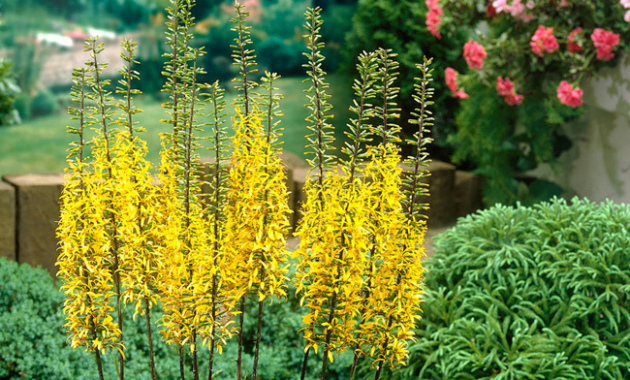
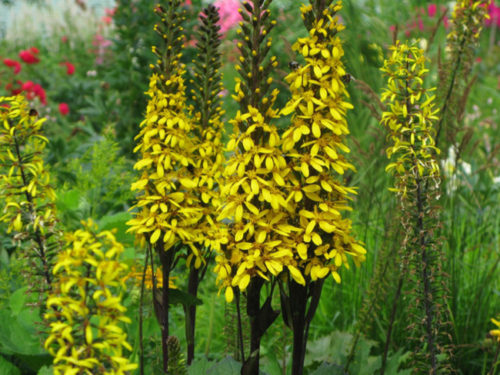
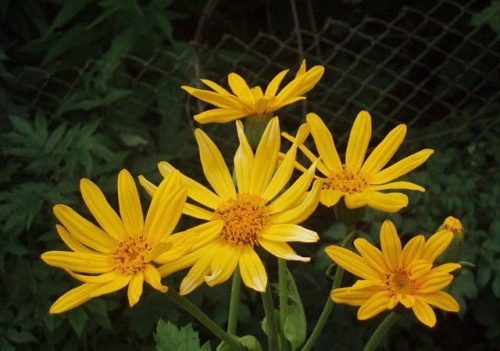
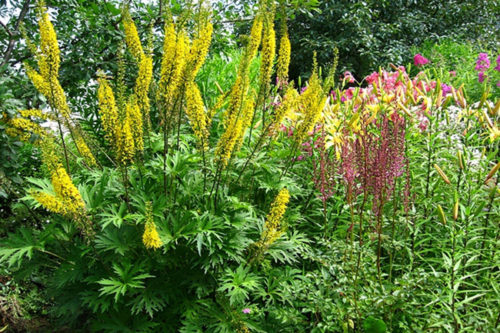
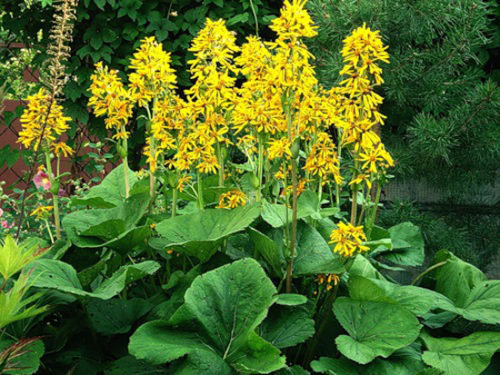
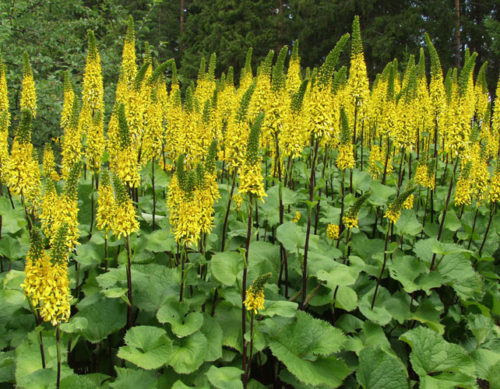
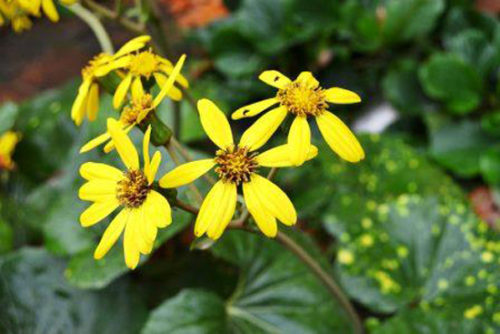
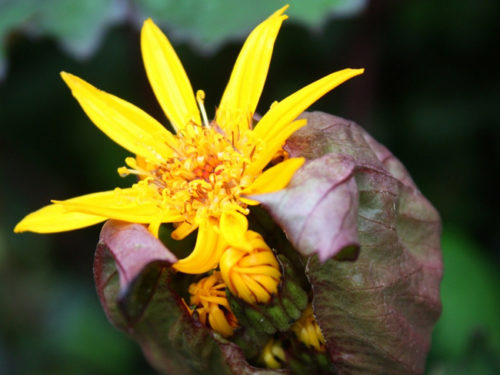
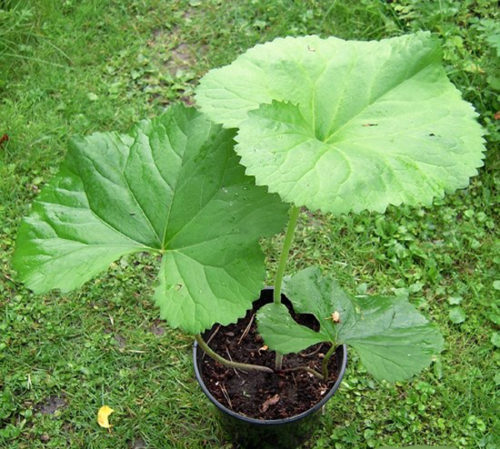
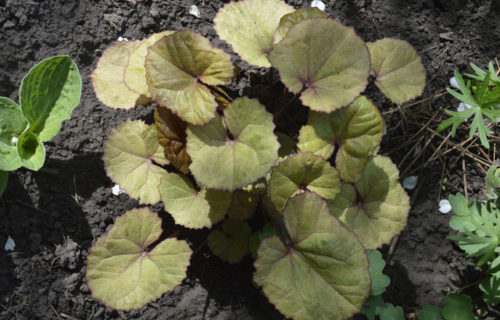
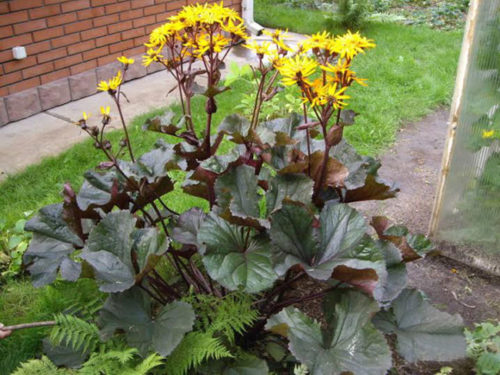
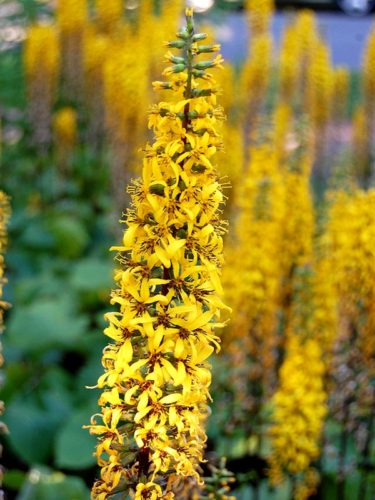
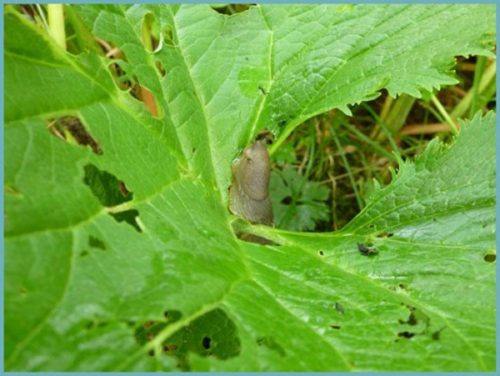
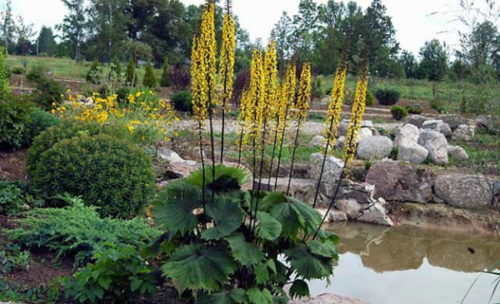
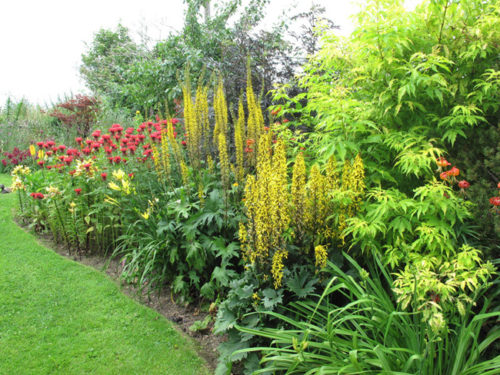
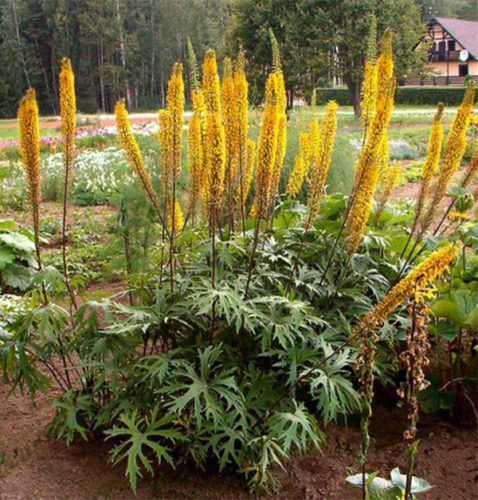












 Start a discussion ...
Start a discussion ...